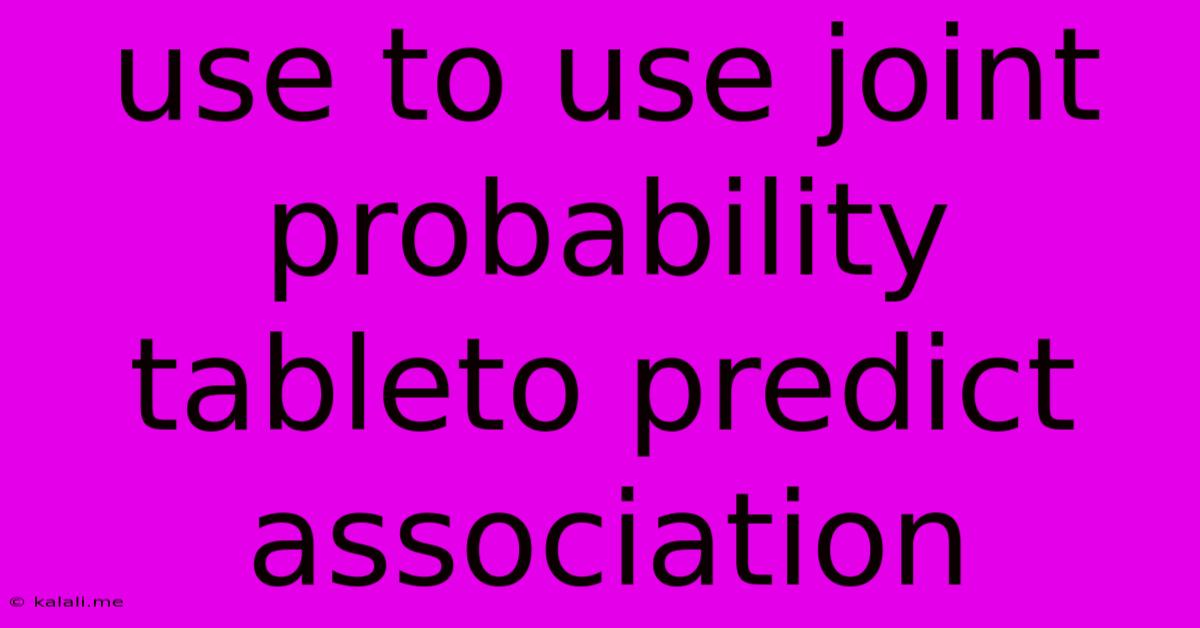Use To Use Joint Probability Tableto Predict Association
Kalali
May 26, 2025 · 4 min read

Table of Contents
Using Joint Probability Tables to Predict Association: A Comprehensive Guide
Meta Description: Learn how to leverage joint probability tables to effectively predict associations between variables. This guide covers calculating probabilities, understanding conditional probability, and interpreting results for insightful data analysis.
Understanding the association between variables is crucial in many fields, from market research and healthcare to engineering and finance. One powerful tool for uncovering these relationships is the joint probability table. This guide will walk you through using joint probability tables to predict associations, explaining the concepts and providing a practical approach to analysis.
What is a Joint Probability Table?
A joint probability table, also known as a contingency table, displays the joint probabilities of two or more discrete random variables. It shows the probability of each possible combination of outcomes for these variables. For example, if we are examining the relationship between gender (male/female) and preference for coffee (yes/no), a joint probability table would present the probability of being male and preferring coffee, being female and preferring coffee, and so on.
Constructing a Joint Probability Table
To create a joint probability table, you need data on the variables you are interested in. Let's use the coffee preference example:
| Gender | Coffee Preference | Count |
|---|---|---|
| Male | Yes | 50 |
| Male | No | 30 |
| Female | Yes | 60 |
| Female | No | 40 |
| Total | 180 |
From this data, we can calculate the joint probabilities:
- P(Male and Yes) = 50/180
- P(Male and No) = 30/180
- P(Female and Yes) = 60/180
- P(Female and No) = 40/180
This translates to a joint probability table:
| Gender | Coffee Preference | Joint Probability |
|---|---|---|
| Male | Yes | 5/18 |
| Male | No | 1/6 |
| Female | Yes | 1/3 |
| Female | No | 2/9 |
Calculating Marginal Probabilities
The marginal probabilities represent the probability of each individual variable regardless of the other. These are calculated by summing the joint probabilities across rows or columns. For instance:
- P(Male) = P(Male and Yes) + P(Male and No) = 5/18 + 1/6 = 8/18 = 4/9
- P(Female) = P(Female and Yes) + P(Female and No) = 1/3 + 2/9 = 5/9
- P(Yes) = P(Male and Yes) + P(Female and Yes) = 5/18 + 1/3 = 11/18
- P(No) = P(Male and No) + P(Female and No) = 1/6 + 2/9 = 7/18
Understanding Conditional Probability
Conditional probability helps us understand the probability of one event given that another event has already occurred. It's calculated using the formula: P(A|B) = P(A and B) / P(B).
For example, what is the probability that a person prefers coffee given that they are male?
P(Yes|Male) = P(Yes and Male) / P(Male) = (5/18) / (4/9) = 5/8
This means there's a 5/8 probability a male prefers coffee.
Predicting Association: Independence vs. Dependence
If the variables are independent, the joint probability is simply the product of the individual probabilities: P(A and B) = P(A) * P(B). If this equation doesn't hold, the variables are dependent, indicating an association. By comparing the joint probabilities with the product of marginal probabilities, we can assess the strength and direction of the association. Significant deviations suggest a strong association.
For example, comparing P(Male and Yes) with P(Male) * P(Yes) will help determine if gender and coffee preference are independent or associated.
Limitations and Considerations
Joint probability tables are most effective with discrete variables. For continuous variables, you might need to discretize them into intervals. Also, the accuracy of predictions depends heavily on the quality and representativeness of the data used to create the table. Larger sample sizes generally lead to more reliable results.
Conclusion
Joint probability tables provide a valuable tool for exploring and quantifying associations between variables. By understanding how to construct, interpret, and utilize these tables, you can gain insightful information about relationships within your data, helping you make more informed decisions and predictions. Remember to always consider the limitations of this method and ensure your data is appropriately representative.
Latest Posts
Latest Posts
-
How Many Days In A Million Minutes
Jul 14, 2025
-
How Many Days Is In 11 Weeks
Jul 14, 2025
-
How Many Grams Are In One Tola Gold
Jul 14, 2025
-
How Many Oz In A Pound Of Freon
Jul 14, 2025
-
How Many Years Are In A Millennia
Jul 14, 2025
Related Post
Thank you for visiting our website which covers about Use To Use Joint Probability Tableto Predict Association . We hope the information provided has been useful to you. Feel free to contact us if you have any questions or need further assistance. See you next time and don't miss to bookmark.